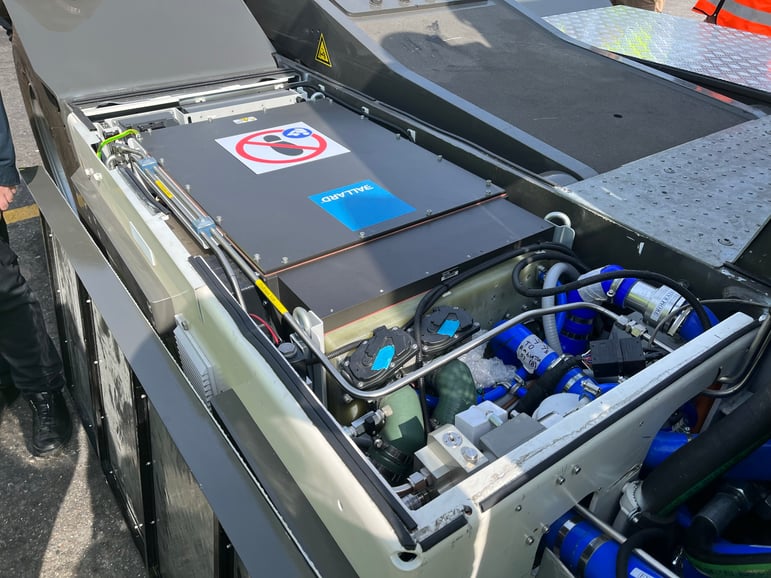
Over 80% of the volume of international trade is carried by sea and port terminals, contributing significantly to global CO2 emissions. These emissions stem from a combination of activities, including vessel operations, cargo handling and onshore energy consumption. According to the 4th IMO Greenhouse Gas (GHG) Study, maritime transport was responsible for approximately 2.9% of global CO22 emissions in 2018. Of this, port-related operations constitute a substantial portion of the emissions.
Being a focal point of trade and commerce, often located near populated areas where emissions contribute directly to local air quality issues, many ports are now committing to achieving carbon neutrality by adopting alternative energy sources. Transitioning to renewable sources such as solar, wind and hydrogen can significantly lower emissions from cargo handling activities.
The H2Ports project, funded by the Clean Hydrogen Partnership, is the first application and demonstration of hydrogen technologies in port handling equipment in Europe. Based at the Port of Valencia, Spain, two fuel cell-powered vehicles – a reach stacker and a yard tractor – are both tested in live operations. The 4x4 RORO terminal tractor is powered by a 70kW fuel cell module from Ballard.
Benefits of using hydrogen fuel cells at ports
Port operations are a very complex ecosystem including multiple types of port equipment such as forklifts, terminal or yard tractors, drayage trucks and reach stackers – to mention a few of the vehicles and machinery that typically operate at ports. Today, a large part of the equipment in service are still powered by diesel combustion engines – representing a huge potential for converting these vehicles into operating on zero-emission fuels. You can replace the diesel engine with a hydrogen fuel cell module without having to worry about it interfering with the operation and constant moving demands of ports.
Fuel cells generates electricity, while energy is stored as hydrogen fuel in vehicle tanks. The fuel cell power system will produce electricity for the port vehicle as long as hydrogen is available. Furthermore, if the vehicle is fueled with hydrogen produced from renewable energy sources, it is a green, zero-emission solution.
Port equipment, powered by hydrogen fuel cells, can meet the tight schedule, demanding payload and 24-7 operational time, which is often required at ports. In addition, fuel cells offer quick, flexible refueling, efficient power and low maintenance costs. Fuel cells also eliminate local emissions such as CO2 and NOX as well as noise, offering significant improvement to the air quality for the local community. Therefore, it is the most promising, reliable, and scalable power solution that can meet zero-emission power requirements and satisfy the key needs of port operators.
Implementing zero-emission port vehicles at the Port of Valencia
The Port of Valencia is paving the way for the deployment of hydrogen in Europe with plans to convert its docks into a zero-emission zone by 2030.
Through the H2Ports project, two non-road port applications installed with fuel cells are demonstrated and validated in a real port environment. A reach stacker to handle containers in the MSC Terminal Valencia and a terminal tractor at the Valencia Terminal are tested and concurrently, making them the first port vehicles in a European port to be powered by fuel cells.
The terminal tractor arrived at the port of Valencia in April 2023, where it will be tested and run daily during two years of real operational activities.

The 4x4 RORO terminal tractor is powered by a 70kW fuel cell module from Ballard along with a battery hybrid powertrain, which is particularly suitable for powering demanding applications and allows the vehicle to perform the intensive tasks that are required during roll-on/roll-off operations. The electric motor can receive power for traction from the fuel cell and battery simultaneously or charge the battery during braking or decelerations. At the same time, the fuel cell can provide power both to the electric motor and the battery, if needed.
The terminal tractor’s hydrogen storage system, made of four Type 3 cylinders (350 bar), has an overall capacity of around 12 kg, which guarantees a continuous operation of at least 6 hours before refueling, corresponding to the average duration of a working shift. However, when the tractor needs to be refueled, it can be done within 5-8 minutes.
Along with the two vehicles, a hydrogen refueling station, specially designed for the project, is also installed at the port of Valencia. However, since the two vehicles will operate in different terminals of the port and cannot circulate outside the terminal area, the station is developed as a flexible and mobile solution.
Future proofing with fuel cells
With the increasing pressure to decarbonize and stringent environment regulations coming to the marine industry, port operators need to make the change to alternative energy sources. The good news is that ports have great potential to reduce their carbon footprint and can play a key role in the world’s decarbonization challenge.
Hydrogen and fuel cell technology has significant advantages for a variety of port applications. Comparing to port equipment running on diesel, hydrogen fuel cell vehicles lower emissions significantly and can still meet the intensive duty cycles, demanding payload and power requirements often associated with port operations.
At this point, a standardized “off-the-shelf” fuel cell solution for every type of port equipment is not available. However, pilot projects are taking place all over the world to investigate options to standardize the technology for more widespread adoption.
.jpeg?width=797&height=598&name=IMG_1960%20(1).jpeg)
In addition to port equipment, hydrogen can also be used for drayage trucks transporting containers in and out of the port, tug boats and barges as well as for cold ironing – all elements that can turn ports into hydrogen hubs and accelerate decarbonization.
With projects such as H2ports, fuel cell technology and hydrogen infrastructure can be tested by port operators, providing valuable data and information to showcase how fuel cell technology can help decarbonize the port and marine sector now and in the future.